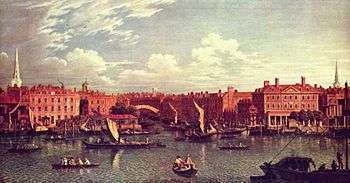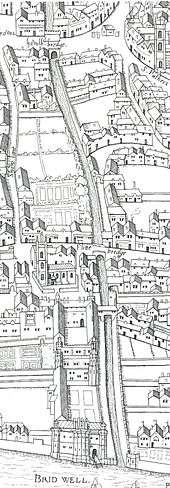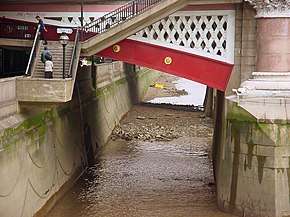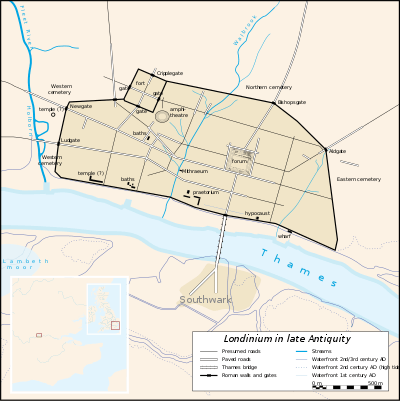River Fleet
The River Fleet is the largest of London's subterranean rivers. Its headwaters are two streams on Hampstead Heath, each of which was dammed into a series of ponds—the Hampstead Ponds and the Highgate Ponds—in the 18th century. At the southern edge of Hampstead Heath these descend underground as sewers and join in Camden Town. The waters flow 4 mi (6 km) from the ponds to the River Thames.


The river gives its name to Fleet Street, the eastern end of which is at what was the crossing over the river known as Fleet Bridge, and is now the site of Ludgate Circus.
Name
The river's name is derived from the Anglo-Saxon flēot "tidal inlet".[1] In Anglo-Saxon times, the Fleet served as a dock for shipping.
The lower reaches of the river were known as the Holbourne (or Oldbourne), whence Holborn derived its name.[2]
The river gives its name to Fleet Street which runs from Ludgate Circus to Temple Bar at the Strand. In the 1970s, a London Underground tube line was planned to lie under the line of Fleet Street, provisionally named the Fleet line. However, it was renamed the Jubilee line in 1977, and plans for the part of the route through the City of London were subsequently abandoned.
Course and tributaries

The Fleet rises on Hampstead Heath as two sources, which flow on the surface as the Hampstead Ponds and the Highgate Ponds. They then go underground, pass under Kentish Town, join in Camden Town, and flow onwards towards St Pancras Old Church, which was sited on the river's banks. From there the river passed in a sinuous course which is responsible for the unusual building line adjacent to King's Cross station; the German Gymnasium faced the river banks, and the curve of the Great Northern Hotel follows that of the Fleet, which passes alongside it. King's Cross was originally named Battle Bridge, referring to an ancient bridge over the Fleet where Boudica's army is said to have fought an important battle against the Romans; the name was changed in the 19th century to refer to a statue of George IV and quickly replaced by the "lighthouse" building that still stands today.
From there, it heads down King's Cross Road and other streets, including Farringdon Road and Farringdon Street. The line of the former river marks the western boundary of Clerkenwell, the eastern boundary of Holborn and a small part of the eastern boundary of St Pancras.[3] In this way it continues to form part of the boundary of the modern London Boroughs of Camden and Islington.
At Farringdon Street the valley broadens out, and straightens, to join the Thames beneath Blackfriars Bridge. In the lower reaches the valley slopes remain very obvious in the surrounding streets, and explain the presence of two viaduct bridges (on Rosebery Avenue where it crosses Warner Street; and at Holborn Viaduct across Farringdon Street), which carry roads over parts of the valley floor.
Lamb's Conduit
A small tributary flowed west to east to join the Fleet near Mount Pleasant. This was later utilised to feed Lamb’s Conduit. The line of the original brook formed Holborn’s boundary with St Pancras to the north. The sweeping curve of Roger Street is part of that boundary line.[4]
Fagswell Brook
The Fagswell Brook (also spelled Faggeswell) was a tributary that joined the Fleet from the east and, in part, formed the northern boundary of the City of London.[5] The brook flowed east to west on a line approximating to Charterhouse Street and Charterhouse Square. In 1603, the historian John Stow described its demise:
Fagges Well, neare unto Smithfield by the Charterhouse, now lately dammed up[6]
A part of the course close to Charterhouse Square was excavated as part of the Crossrail project.[7]
Today

The Fleet, or rather the sewer that now follows its route, can be heard through a grating in Ray Street, Clerkenwell[8] in front of The Coach pub (formerly the Coach and Horses), just off Farringdon Road. The position of the river can still be seen in the surrounding streetscape with Ray Street and its continuation, Warner Street, lying in a valley where the river once flowed. It can also be heard through a grid in the centre of Charterhouse Street, where it joins Farringdon Road (on the Smithfield side of the junction). In wet weather (when the sewer system is overloaded), and on a very low tide, the murky Fleet can be seen gushing into the Thames from the Thameswalk exit of Blackfriars station, immediately under Blackfriars bridge. (The tunnel exit shown in the picture can be seen much more clearly from directly above.)
The former mayor of London, Boris Johnson, proposed opening short sections of the Fleet and other rivers for ornamental purposes,[9] although the Environment Agency – which manages the project – is pessimistic that the Fleet can be among those uncovered.[10]
History
In Roman times, the Fleet was a major river, with its estuary possibly containing the oldest tidal mill in the world.[11] The river secured the western flank of the Roman City.

In Anglo-Saxon times, the Fleet was still a substantial body of water, joining the Thames through a marshy tidal basin over 100 yards (91 m) wide at the mouth of the Fleet Valley. Many wells were built along its banks, and some on springs (Bagnigge Well, Clerkenwell) and St Bride's Well, were reputed to have healing qualities; in the 13th century the river was called River of Wells.[12] The small lane at the south-west end of New Bridge Street is called Watergate because it was the river entrance to Bridewell Palace.
As London grew, the river became increasingly a sewer. The area came to be characterised by poor-quality housing and prisons: Bridewell Palace itself was converted into a prison; Newgate, Fleet and Ludgate prisons were all built in that area. In 1728 Alexander Pope wrote in his Dunciad, "To where Fleet-ditch with disemboguing streams / Rolls the large tribute of dead dogs to Thames / The king of dykes! than whom no sluice of mud / with deeper sable blots the silver flood".[13]

Following the Great Fire of London in 1666, architect Christopher Wren's proposal for widening the river was rejected. Rather, the Fleet was converted into the New Canal, completed in 1680 under the supervision of Robert Hooke. Newcastle Close and Old Seacoal Lane (now just short alleyways off Farringdon Street) recall the wharves that used to line this canal, especially used by the coastal coal trade from the north-east of England. (An adjacent narrow road, Seacoal Lane, also existed until the late 20th century, when the present building fronting onto Farringdon Street was built, perhaps suggesting that a new wharf had been built near the old one.)
The upper canal, unpopular and unused, was from 1737 enclosed between Holborn and Ludgate Circus to form the "Fleet Market". The lower part, the section from Ludgate Circus to the Thames, had been covered by 1769 for the opening of the new Blackfriars Bridge and was consequently named "New Bridge Street".
The development of the Regent's Canal and urban growth covered the river in King's Cross and Camden from 1812. The Fleet Market was closed during the 1860s with the construction of Farringdon Road and Farringdon Street as a highway to the north and the Metropolitan Railway, while the final upper section of the river was covered when Hampstead was expanded in the 1870s.
Cultural references
.jpg)
- Ben Jonson's poem "On the Famous Voyage" provides a mock-epic account of a journey along the excrement-lined ditch during the early 17th century.[14][15]
- Jonathan Swift (author of Gulliver's Travels) mentions the filth in the Fleet during a storm in a poem of 1710:[16]
Sweepings from Butchers Stalls, Dung, Guts and Blood,
Drown'd Puppies, stinking Sprats, all drench'd in Mud,
Dead Cats and Turnip-Tops come tumbling down the Flood.
- In Dickens' Oliver Twist (1837–39), Fagin's lair is on Saffron Hill, adjacent to the Fleet (and in some adaptations, reached by a footbridge across it, which collapses under the weight of pursuers).
- In the Lord Peter Wimsey detective novel Thrones, Dominations, set in 1936 London and begun by Dorothy L. Sayers, but completed by Jill Paton Walsh and published in 1998, Wimsey and Police Superintendent Charles Parker descend into the Fleet and nearby subterranean rivers, in search of the body of a murder victim – and barely escape drowning when a sudden heavy rain causes a flood underground.
- In The Door in the Wall (1949), Marguerite de Angeli's juvenile fiction set in early-14th-century England, Brother Luke soothes lame Robin's anger at being called Crookshanks by explaining to him that they are all named for some quality unique to themselves. He gives as an example Geoffry Atte-Water "because he lives by the River Fleet and tends the conduit there with his father".
- The 1966 Modesty Blaise strip cartoon story "The Head Girls" features the underground section of the Fleet, where Modesty and Willie Garvin are tethered by the villainous Gabriel in the expectation that the rising tide will drown them.
- The 19th-century Fleet is part of one of the settings a story of the Doctor Who serial "The Talons of Weng-Chiang" (1977), starring Tom Baker: in one episode the Doctor claims he once caught a large salmon in the Fleet, which he shared with the Venerable Bede. It is also mentioned in the Eighth Doctor audio adventure Dead London.
- In Neil Gaiman's television serial and novel Neverwhere (1996), the Great Beast of London is said to be a feral boar hog that ran into the Fleet while it was still partially open to the air, and vanished underground into the depths of London Below, growing huge and fat off the sewage.
- The 2003–2004 Baroque Cycle, Neal Stephenson's three volumes series set in the late 17th and early 18th centuries, has many references to the Fleet Ditch, including discussion of the polluted state of the waterway.
- The Christopher Fowler crime thriller The Water Room (2004) uses the Fleet as a major setting.
- In Guy Ritchie's Sherlock Holmes (2009), a blindfolded Sherlock (played by Robert Downey Jr.) uses the presence of the bump at the 'Fleet Conduit' in order to gain his bearings: "After that, the carriage forked left, then right, and then the tell-tale bump at the Fleet Conduit."
- In John Twelve Hawks "The Golden City" (The Fourth Realm Trilogy) 2010, the Fleet is an important part of the chapters 29 and 30.
- The Fleet is mentioned in the novel Rivers of London (2011) by Ben Aaronovitch; and in Blue Monday (2011) by crime novelist Nicci French.
- "London Underground", a 2014 episode of BBC One drama New Tricks, features a storyline about a murder by an occult group in the 1970s who believed that the Fleet demanded human sacrifices.
- The novel Goodnight, John-Boy (2017) by Pat Mills depicts the disposal of a murder victim's body through an access hatch into the Fleet sewer pipe, where it is washed out into the Thames.
See also
- Tributaries of the River Thames
- Subterranean rivers of London
- List of rivers in England
References
- "fleet, n.2". Oxford English Dictionary. Oxford, England: Oxford University Press. 1989.
- Trench, Richard; Hillman, Ellis (1993). London under London: a subterranean guide (Second ed.). London: John Murray. p. 33. ISBN 0-7195-5288-5.
- 'West of Farringdon Road', in Survey of London: Volume 47, Northern Clerkenwell and Pentonville, ed. Philip Temple (London, 2008), pp. 22-51. British History Online http://www.british-history.ac.uk/survey-london/vol47/pp22-51 [accessed 2 August 2020].
- The History of the River Fleet, UCL Fleet Restoration Team, 2009
- From a map based on Stow c.1600, (discussed in "Street-names of the City of London", (1954) by Eilert Ekwall) shows the "Fagswell Brook" south of Cowcross Street as the northern boundary of the City
- 'Introduction', in Survey of London: Volume 46, South and East Clerkenwell, ed. Philip Temple (London, 2008), pp. 3-27. British History Online http://www.british-history.ac.uk/survey-london/vol46/pp3-27 [accessed 27 July 2020].
- article on MOLA excavations http://islingtontribune.com/article/crossrail-engineers-find-500-year-old-shoes-in-clerkenwell-mud
- Ray Street Bridge (off Farringdon Lane), EC1. Streetmap.co.uk. Retrieved on 2013-07-17.
- Boris Johnson to revive London’s lost rivers (payment required)
- Jowit, Juliette (8 January 2009). "River rescue: project launched to breathe life into waterways buried under London concrete and brick". The Guardian. p. 15. Retrieved 8 January 2009.
- Spain, Rob: "A possible Roman Tide Mill", Paper submitted to the Kent Archaeological Society
- Wickstead, Thomas (January 1840). "On the supply of water to the Metropolis". The Civil engineer and architect's journal. III (28): 10.
- Dunciad, book the second
- Jonson, Ben. "On the Famous Voyage". sewerhistory.org. Archived from the original on 23 April 2013. Retrieved 9 April 2013.
- McRae, Andrew (1998). ""On the Famous Voyage": Ben Jonson and Civic Space". Early Modern Literary Studies. 4 (Special Issue 3).
- Talling, Paul. "London's Lost Rivers: River Fleet". Retrieved 24 January 2016.
External links
- Sub-Urban.com — River Fleet
- Photos From The Buried River Fleet
- Chesca Potter, "The River of Wells"
- Map showing Ray Street Bridge
- Google Earth view of Hampstead Heath, showing the Hampstead Ponds and the Highgate Ponds.
| Next confluence upstream | River Thames | Next confluence downstream |
| River Effra (south) | River Fleet | Walbrook (north) |